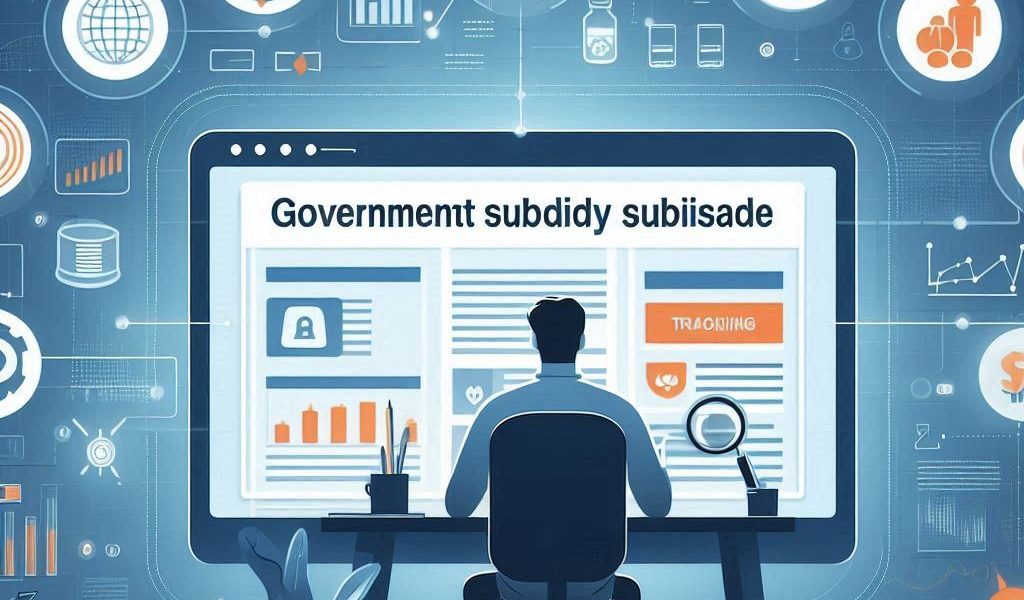In today’s world, government subsidies and grants serve as an essential source of financial support for various sectors of society, from entrepreneurs and small businesses to students and farmers. However, despite the abundance of subsidies available, many individuals and businesses fail to make the most of these opportunities. The key to unlocking the full potential of government subsidies is knowing how to track them and maximize the benefits.
In this blog, we will provide you with a comprehensive guide on how to track government subsidies effectively and maximize the benefits for your business, education, or personal endeavors.
Understanding Government Subsidies and Grants
Before delving into tracking and maximizing government subsidies, it’s important to understand what they are and how they function.
Government subsidies are financial aids or incentives provided by the government to support businesses, individuals, or organizations in specific sectors. These may include agricultural subsidies, business grants, education scholarships, or healthcare subsidies. The goal is to encourage growth, support economic development, and assist in various socio-economic objectives.
Types of Government Subsidies and Grants:
- Subsidies for Agriculture: Farmers receive financial assistance to promote sustainable farming practices, improve crop yield, and adopt advanced agricultural techniques.
- Business Grants: Financial support for small and medium-sized businesses (SMBs) to stimulate entrepreneurship and foster innovation.
- Education Grants: Financial assistance for students pursuing higher education or research programs.
- Healthcare Subsidies: Assistance for low-income individuals and families to make healthcare more affordable.
- Renewable Energy Subsidies: Incentives to encourage the adoption of solar, wind, and other renewable energy sources.
Step 1: Identifying Available Subsidies
The first step in tracking and maximizing government subsidy benefits is identifying which subsidies are available to you. This process depends on the specific sector or type of financial support you are looking for.
How to Identify Available Subsidies:
- Government Websites: Most governments provide details about available subsidies on their official websites. Look for the Ministry of Finance, Ministry of Agriculture, Ministry of Skill Development, and other sector-specific departments.
- State Government Portals: Each state has its own set of subsidies, grants, and welfare schemes. Visit your state’s official government portal to access information on state-specific programs.
- Subsidy Databases: Several platforms aggregate information on government subsidies. These may be third-party websites or portals managed by government bodies, like the National Portal for Government Schemes or Subsidy and Grant Finder.
- Consulting Agencies: Some organizations help businesses and individuals apply for government subsidies. These agencies often provide a list of available subsidies along with guidance on eligibility.
- Newspapers and Official Bulletins: The government regularly publishes notices and updates on subsidy schemes through local newspapers, circulars, or public announcements.
Step 2: Checking Eligibility Criteria
Once you’ve identified the subsidies or grants available in your region or sector, the next crucial step is to check eligibility. Understanding whether you qualify for a specific subsidy is essential before proceeding with the application.
How to Check Eligibility:
- Read Scheme Guidelines: Every government scheme comes with specific eligibility criteria, such as income limits, business size, location, or educational qualifications. These are usually available on the scheme’s official page.
- Eligibility Calculators: Some schemes provide online eligibility calculators. These tools allow you to input your details (e.g., age, income, business size) to assess whether you qualify for the subsidy.
- Consult with Experts: If you are unsure about your eligibility, you can consult with professionals or agencies that specialize in government schemes. They can assess your situation and guide you through the process.
- Feedback from Beneficiaries: If possible, reach out to others who have previously benefited from the same scheme. Their insights can help you understand the nuances of the eligibility requirements.
Step 3: Application Process
Once you’ve identified which subsidies or grants apply to you and confirmed your eligibility, the next step is to apply for the subsidy. The application process is often straightforward but can vary depending on the type of subsidy.
How to Apply for Subsidies:
- Online Portals: Many government subsidies and grants can be applied for online through official portals. This is often the easiest and fastest method.
- Required Documentation: You will need to gather necessary documents such as identity proof, income proof, project proposals, academic certificates, or business-related documents.
- Application Form: Complete the application form accurately, ensuring all required information is provided. Incomplete applications may result in delays or rejections.
- Submit Application: Submit your application through the official channel, whether it’s an online platform or at a government office.
- Follow-up: After submission, make sure to follow up regularly on the status of your application. Some programs may require additional documents or clarifications.
Step 4: Track Your Application Status
Tracking the status of your subsidy application is an essential part of the process. Many schemes offer online tracking systems, where you can check the progress of your application.
How to Track Your Application:
- Government Portal Tracking: Most government portals allow you to track the status of your application using the reference number provided after submission.
- SMS/Email Alerts: Some programs send SMS or email notifications to keep applicants updated about their application status or any changes in the process.
- Helplines: If you do not have access to the internet, you can contact the government helplines to inquire about your application status.
- In-Person Visits: For certain subsidies, you may need to visit the relevant government department or agency for updates or to resolve issues.
Step 5: Maximize Your Government Subsidy Benefits
Now that you’ve applied for your subsidy and are tracking its progress, it’s time to maximize the benefits. The goal is to ensure that you fully utilize the financial aid provided and make the most of the resources available.
Tips to Maximize Your Subsidy Benefits:
- Stay Updated on Policy Changes: Government schemes often evolve with time. Keep yourself informed about any updates, changes in deadlines, or modifications in terms and conditions of the subsidy programs.
- Utilize Additional Financial Benefits: Some government subsidies come with added benefits, such as low-interest loans, tax exemptions, or rebates. Make sure you explore these options to maximize your financial advantages.
- Plan Your Business or Personal Goals: For businesses, subsidies can be a great way to fuel growth, expand operations, or invest in new technologies. Have a clear strategy for how the funds will be utilized to drive long-term success.
- Submit Reports and Audits on Time: Some subsidies require beneficiaries to submit progress reports or financial audits. Ensure you meet deadlines for these reports to maintain eligibility for continued support.
- Use Funds Wisely: Whether you are using the subsidy for educational purposes, business development, or research, always use the funds wisely. This not only ensures you meet the program’s expectations but also maximizes the benefits for long-term growth.
Step 6: Avoid Common Pitfalls
While applying for and tracking government subsidies, there are several common mistakes that can hinder the process. Be aware of these pitfalls:
- Missed Deadlines: Government schemes often come with strict deadlines. Missing deadlines can result in your application being disqualified.
- Incomplete Documentation: Ensure all required documents are submitted along with your application. Missing documents can delay or even cancel your application.
- Lack of Follow-Up: Many applicants forget to track their application status or fail to follow up when necessary. Regular follow-ups ensure that you don’t miss important notifications.
- Failure to Meet Eligibility Criteria: Always verify that you meet the eligibility requirements before applying. Applying without fulfilling the conditions can waste your time and effort.
Conclusion
Government subsidies and grants are excellent opportunities to receive financial assistance for personal, educational, or business growth. To track and maximize your subsidy benefits, it’s crucial to follow a structured approach: identify available schemes, check eligibility, apply promptly, track your application status, and make the most of the benefits provided.
By staying informed, following the application procedures carefully, and managing your subsidy benefits effectively, you can unlock the full potential of these government programs. Always ensure that your approach is compliant with legal guidelines to avoid any unnecessary complications.
With the right knowledge and strategy, you can leverage these financial aids to fuel your growth, whether as a business owner, student, or individual seeking support.



